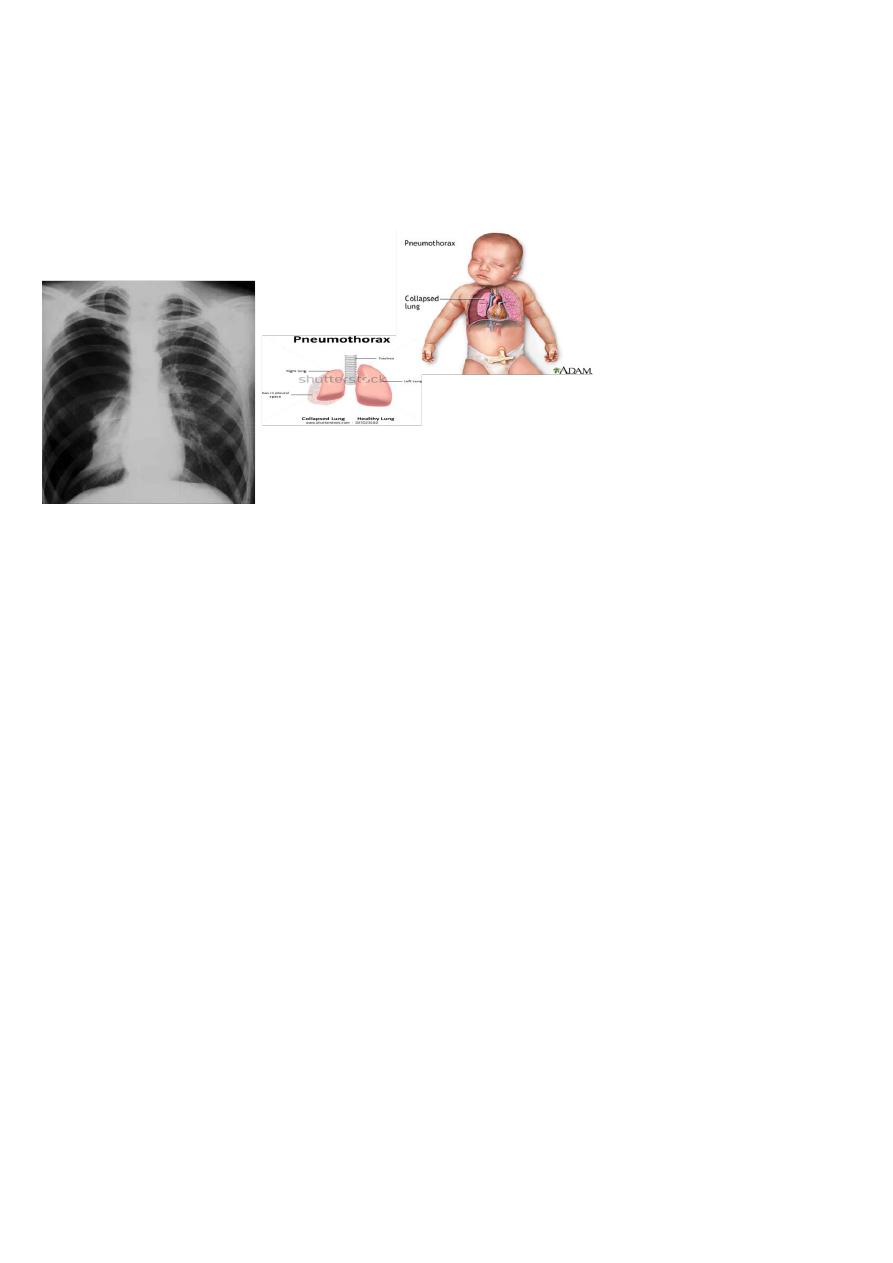
Pneumothorax
Is accumulation of air gas in a pleural space or accumulation of extra pulmonary air
within the chest which can impair oxygenation and ventilation.
Is uncommon during childhood , may result from external trauma , iatrogenic
,pulmonary diseases or mat be spontaneous.
• Causes :--
1-chest trauma
2- iatrogenic *
3– pulmonary dis as in : asthma ( occurs in 5% of asthmatic patients ) due to rupture of
emphysematus bleb .
pneumonia :- in connection with empyema ( pyo-pneumothorax) as in staph pneumonia .
cystic fibrosis :- occurs in 10-25% which commonly above 10 years of age .
kerosene pneumonitis
4- collagen disease :-- like marfan syndrome , Ehlor danols synd histiocytosis .
• Pneumothorax may associated with pleural effusion ( hydro-pneumoThorax ) or
purulent effusion ( pyo-pneumothorax ) It is common unilateral , while bilateral is rare
beyond neonatal period
• * iatrogenic ;- as in complication of tracheostomy , Endotracheal intubation ,
thoracocentesis . .
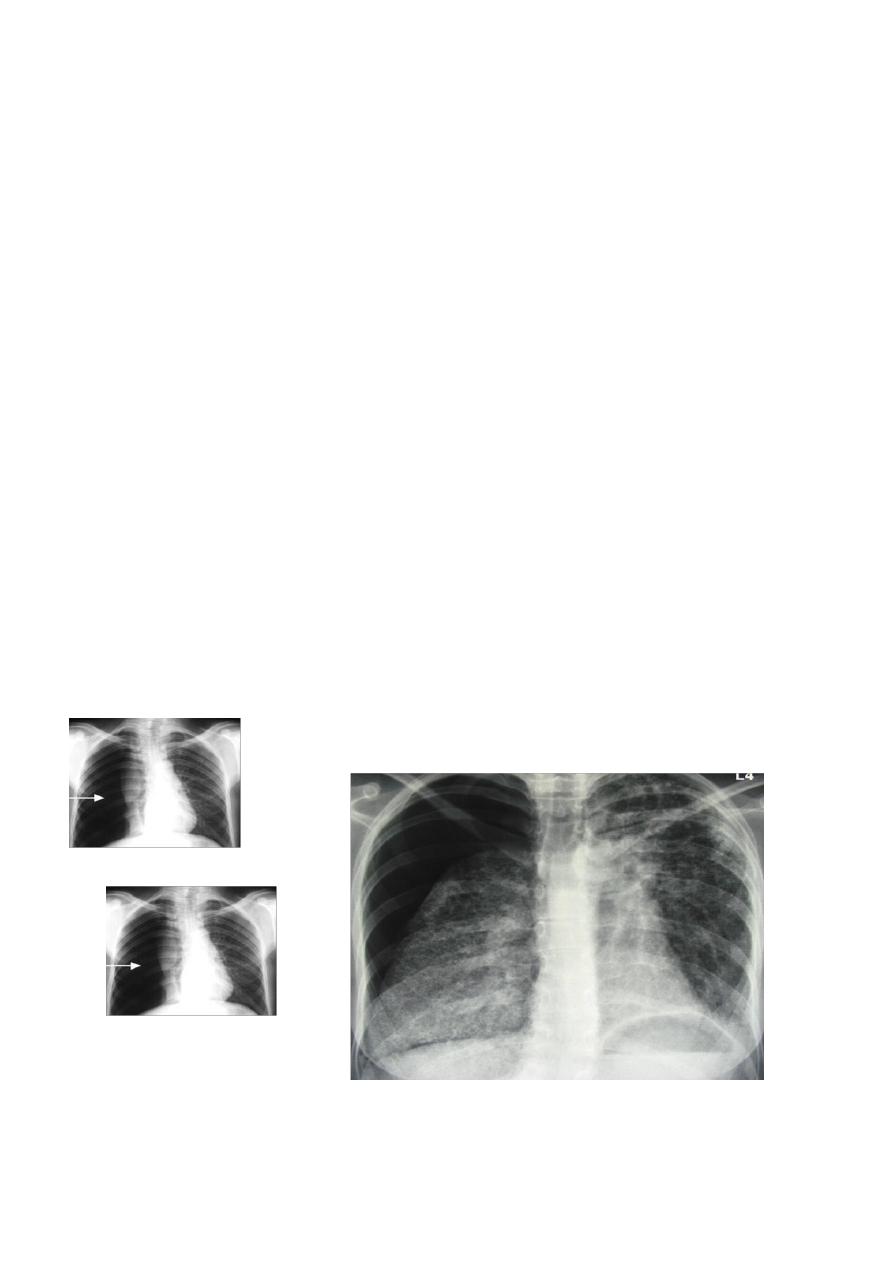
ClF :--
severity of symptom depend on :-- a- extent of disease ( extent of lung collapse)
b-amount of pre-existing lung dis.
• In infancy :- the S&S is difficult to recognize ( as irritable , dyspnea , cynosis)
• In spontaneous pneumo-thorax :- may occurs while patients at rest( no clinical sign and
symptoms in primary spontaneous until bleb ruptures causing pneumothorax
• moderate pneumothorax caused little displaced of intra-thorax organ caused few or
no symptoms .
• Extensive pneumothorax leading to sever chest pain & dyspnea & may be cynosis
especially in children .
• Severity of chest pain usually does not directly reflect of extent of collapse .
OlE :--
1- sign of respiratory distress
2- decreased breath sound
3- tympanic by percussion unless associated with empyema or pleural effusion leading to
dullness
4- shifting of mediastinum to opposite side

Diagnosis :--
• ClF( history and physical examination remain the keys for the diagnosis ) + CXR
in infant translumination of chest wall helps in rapid diagnosis .
• It is important to determine whether this pneumothorax undertension
( tension pneumothorax ) Because of causing limitation of contra lung expansion
leading to compromise venous return .
Feature of tension pneumo-thorax :---
1-presence of circulatory collapse
2- evidence of an audible of Hiss of rapid exist of air with insertion of chest tube .
3- mediastinum shifting to opposite site ( sometime no shifting ,if there is bilateral pneumo
thorax or stiff lung of both side )
DD:--
1- localized or generalized emphysema 2- cystic fibrosis 3-diaghramatic hernia
Treatment :---
• depend on extent of pneumo thorax , nature & severity of underlying disease :--
1- if collapse of less 5% ( mild to moderate ) often resolve spontaneously within one week
& increase or hasten resolution by given high concentration of O2 100% that
increased nitrogen pressure gradient between pleural air & blood .
2- if collapse is extensive of more than 5% (extensive ) or recurrent or under tension
needs chest tube with air drainage .
Pleurodesis ( is obliteration of pleural space ) is indicated if
1- pneumo-thorax is recurrent
2- if the cause is is cytic fibrosis or malignancy .
Pleurodesis : is introduction of chemical substance by chest tube into pleural cavity like
tetracyclin or silver nitrate .
3- treatment of underlying lung dis.
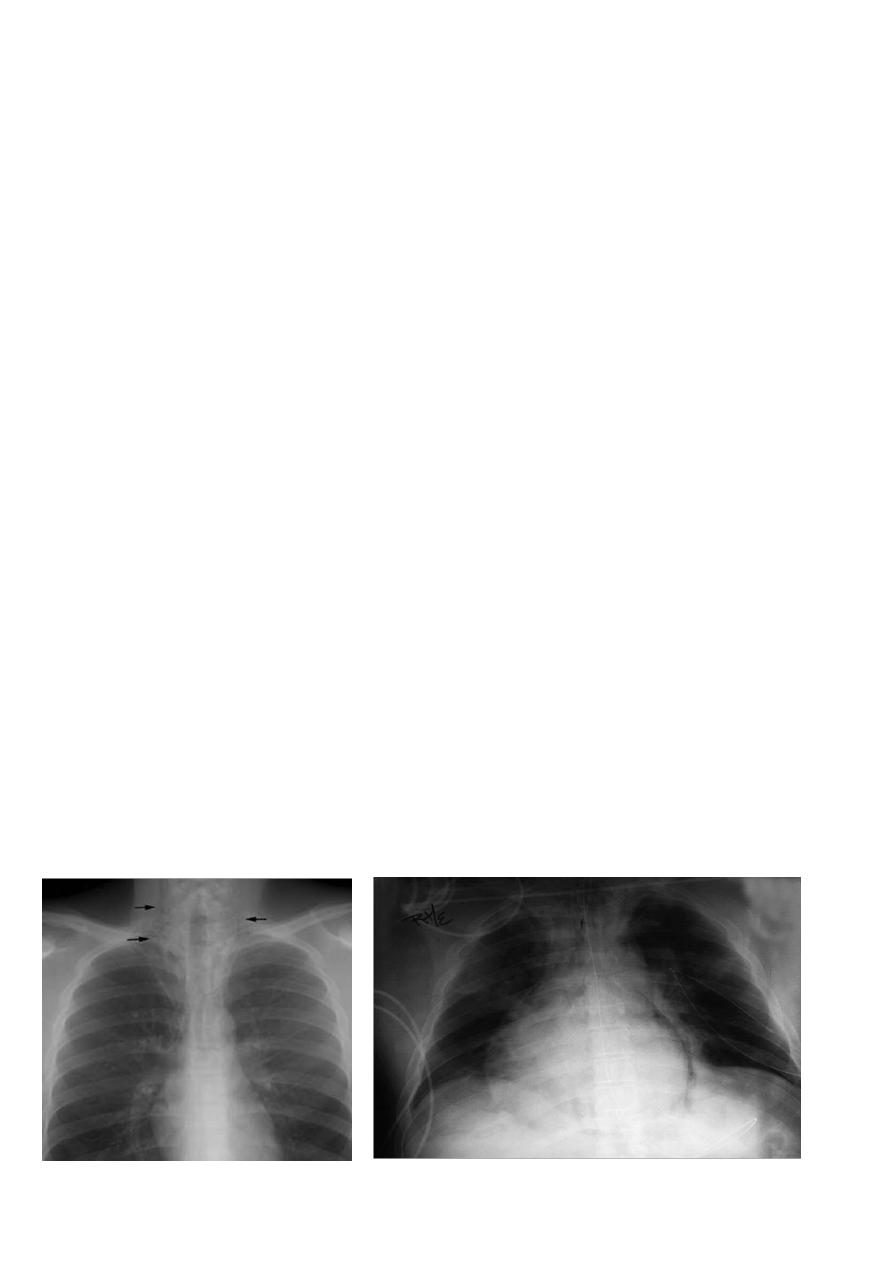
Pneumo-mediastinum :--
is presence of air or gas in the mediastinum , resulting from dissection of air from a leak in
a pulmonary parenchyma into mediastianum ( ecessive intra alveolar pressures lead to
ruptures of alveoli bordering the mediastinum where air escapes into the surrounding
connective tissues and dissect into further into the mediastinum .
Causes :---
1-asthma ( commonest cause
2-trauma ( penetrate chest trauma , or esophageal perforation )
3-may associated with dental extraction ,D.K.A, acute puncture , acute G.E .
4-idiopathic ( occasionally )
5- sever coughing
6- mechanical ventilation
• It is rarely a major problem in a children because of air leak going into neck or abdomen
without affection of mediastinum .
ClF:--
chest pain ( transient stabbing that may radiate to the neck is principle feature of
pneumo-mediastinum )
OlE
:--may be absent or just crunching noise over sternum by auscultation . DKA(diabetic
ketoacidosis) , G.E(gastroenteritis )
• Subcutaneous emphysema if present is diagnostic . Diagnosis is confirmed by chest x-
ray which showing mediastinum air with more distinct cardiac border than normal .
Treatment
:-treatment of underlying disease .
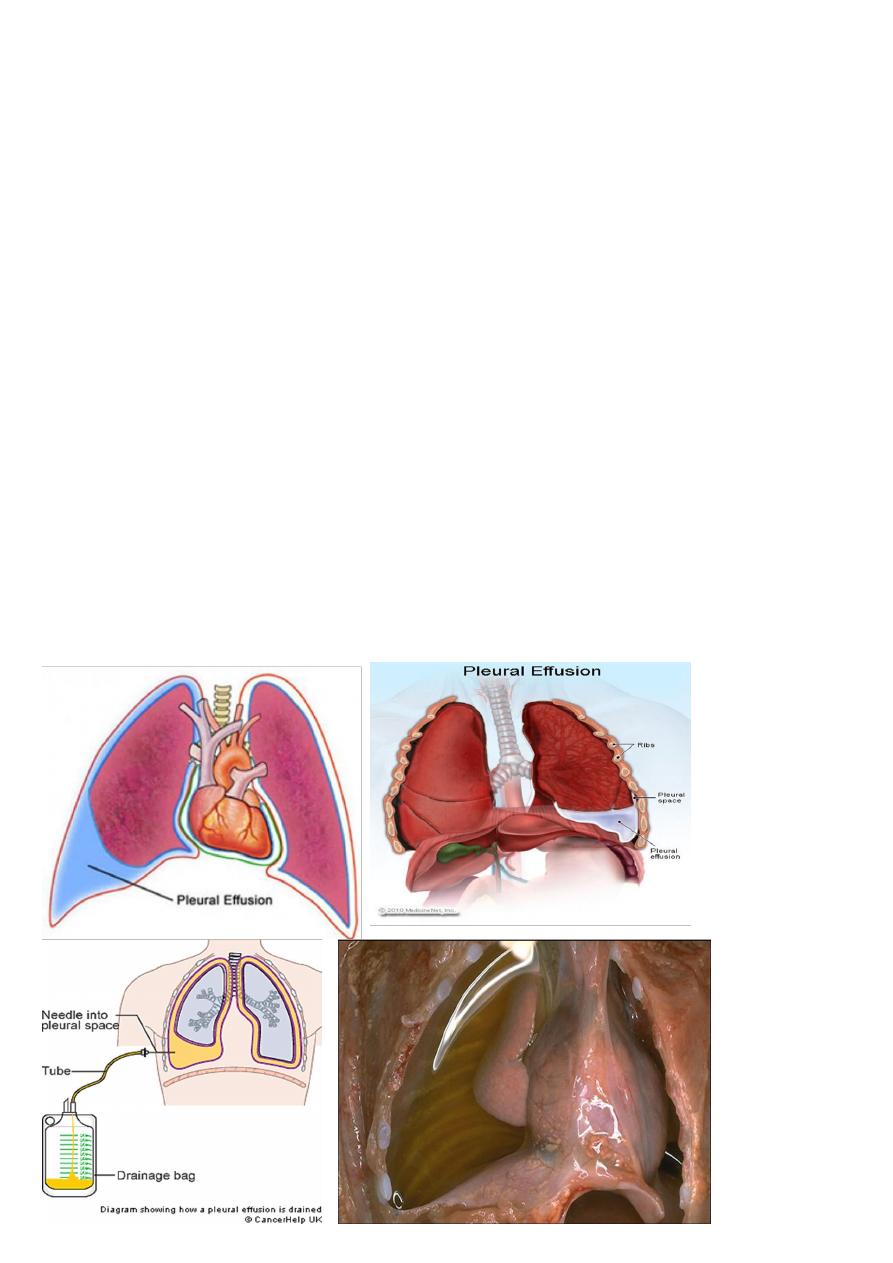
Pleurisy and pleural effusion :--
• is fluid collection in a pleural cavity which either serous or purulent , can be
differentiate between them through fluid aspiration & send for protein , sugar , cell
specific gravity, lactate dehydrogenase (L.D) pleural fluid is of less than 1 cc between
pariatal and visceral layers )
serous exudate
1-specific gravity less than 1015 more than 1015
2-protein less than 2.5gmldl more than 3gmldl
3-sugar normal less than 60mgldl
4-cell low cell count high cell count
mainly PMN
5-LD less than 200 IUlL more than 200 IUlL
6-PH less than 7.2
• Note :--normal PH of pleural fluid 7.6
X-RAY
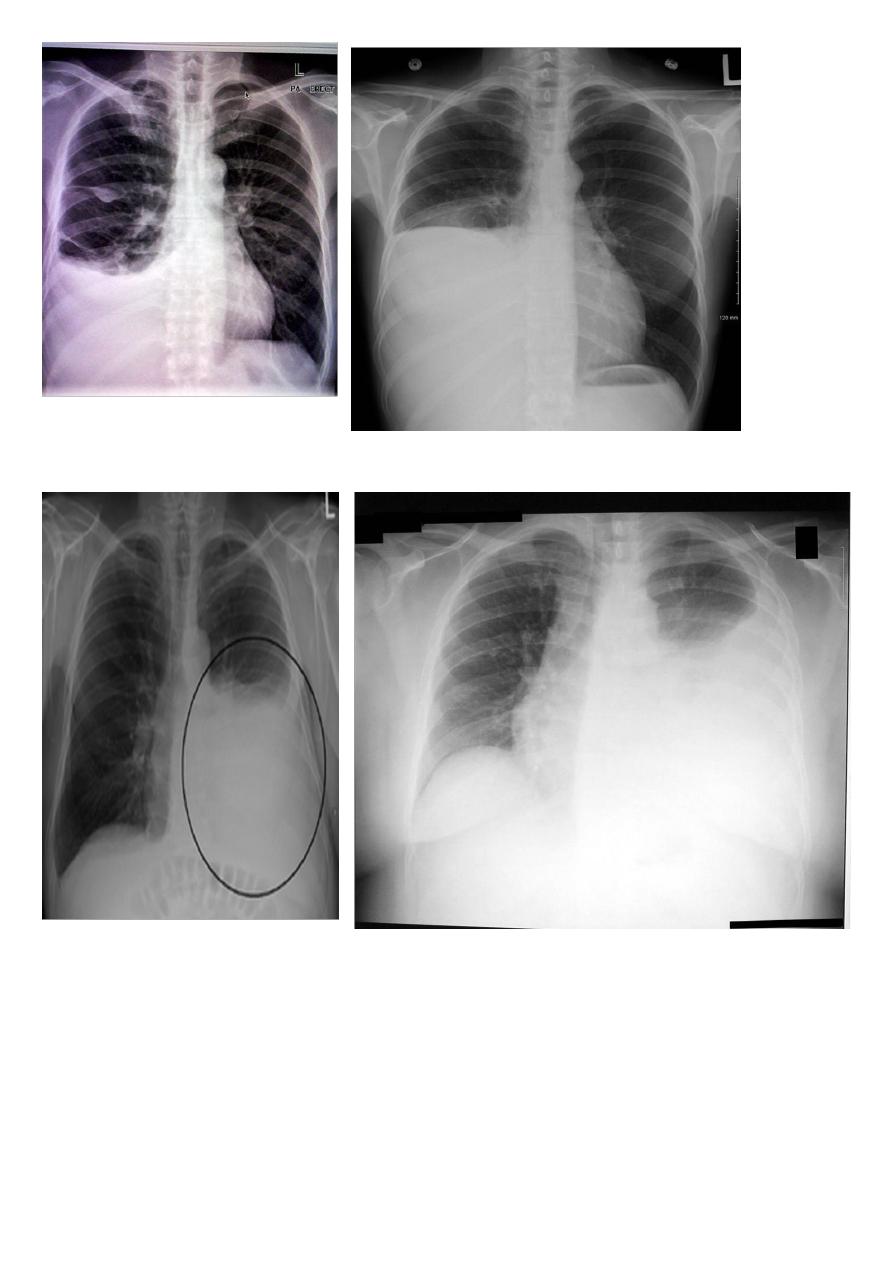
• The commonest cause of effusion is bacterial pneumonia & next CHF,
hypoproteinemia , rheumatological causes, metastatic intra-thoracic
malignancy & others like T.B , SLE ,aspiration pneumonitis .

Pleurisy :--
• is inflammation of pleural membrane , classify into 3 type :--
1-dry or plastic type 2- sero-fibrinous 3-purulent type
1-Dry pleurisy :--- its process limited to visceral pleura with small amount of serous fluid .
Causes :--
1- acute bacterial pneumonia & T.b
2- may associated with connective tissue dis. Like Rheumatic fever
3-may develop during course of URTI ( upper resp. tract infection )
ClF :--
• cardinal feature is chest pain which increased by coughing , straining , breathing &
some time describe as dullache which less likely vary with breathing , the pain is
refered to back , shoulder , responsible for grunting , guarding of respiration .
• x-ray diffuse hizziness at a pleural space or dense , sharply demarcated shadow
DD:--
1-pleurodynia 2-trauma to rib cage 3-tumour of spinal cord 4-herpes zoester .
Note :- any patient with pleurisy + pneumonia should always screened For T.B .
• Treatment :- treatment of underlying dis. + analgesia NSAID
2- Sero-fibrinous pleurisy :--
• is defined by a fibrinous exudate on the pleural surface & an exudate effusion of serous
fluid into the pleural cavity .
Causes :--
1- most commonly associated with infection of lung or inflammatory condition of abdomen or
mediastinum .
2- less commonly associated with SLE, Rheumatic fever , lung malignancy .
ClF :---
1- often proceed by dry pleurisy .
• 2- when fluid collection , the pain is disappeared & the patients Asymptomatic .
• Note :- if effusion remain small :- have only sign and symptoms of underlying dis., but ,
if effusion become large leading to resp Distress .

OlE :--
depend on amount of fluid :--
• large effusion : dullness by percussion
• in infant : there is bronchial breathing
Diagnosis :--
1- ClF 2- X-ray finding 3- WBC 4-thoraco-centesis
Course :- effusion is usually disappeared rapidly ( unless fluid collection with exudate) by
appropriate antibiotic . if persist ( longer ) suspected possibility T.B , neoplasm ,
connective tissue dis., Empyema
Treatment :--
1- treatment of underlying dis .
2-if larg effusion , :-needs drainage make the patient more comfortable & removal of not
more than one litter ( if drainage of more than one litter leading re-expansion of pulmonary
disease. if become purulent : needs chest tube drainage
Purulent Effusion :-
is a accumulation of pus in a pleural space , most often associated
with bacterial ( staph infection ) & less frequently with pneumococcal & H. influenza .
• Empyema is most often encountered in infant & pre-school children and is account
about 0.6 -2% of children with bacteria pneumonia .
• If pus not drained : may dissect through pleura into lung parenchyma producing
broncho- pleural fistula & pyo-pneumothorax
OlE :--
• most frequently in infant & pre-school children , occurs in 5-10% of patients with
bacterial pneumonia And up to 86%of children with necrotizing pneumonia
1- interval of few days between onset of bact. Pneumonia & empyema if not treated well .
2- fever in most of pts 3- respiratory distress
4- if fluid is not shifted with change position , indicated loculated empyema which reverse to
serous effusion that shifted with change position .
• Thoraco-centesis should drained as much as possible & send for gram stain , culture
The effusion is empyema if bacteria are present on gram stain ,ph of less than 7.2 , PMN
of more than 100000/µL

CX:--
1-broncho-pleural fistula & pyo-pneumo-thorax ( commonest cx)
2- others like purulent pericarditis , pul abscess , peritonitis & osteomylitis of ribs
3- septic cx like meningitis , arthritis , osteomylitis
4- septecemia ( occurs infrquently with staph , is often occurs by H-influenza pneumo-
coccal .
Treatments :---
1- pus drainage ( continue for about one week even small amount of pus , when no longer
drained , removed chest tube )
2-A.B antibiotic Like methicicline for staph , pencilin or ceftriaxone for pneumococal and if
resistance , given vancomycin & ceftriaxone or cefotaxime or ampiciline plus chloromphenicol
for H.influenza duration of antibiotic : staph for 3-4 wks
3- if pneumatocelle ; no treatment unless sufficient size which embrass respiration or
secondary infected ( treated by surgery )
4- instillation of fibrinolytic agent into pleural cavity promote drainage, decreased fever, less
for surgical interference , shorten hospitalization like streptokinase 1500unit / Kg in 50 ML
normal saline for 3-5 days or urokinase 40000 unit in 40 ML of normal saline twice for 3 days.
note :-- A.B (antibiotic) Cx ( complication )
